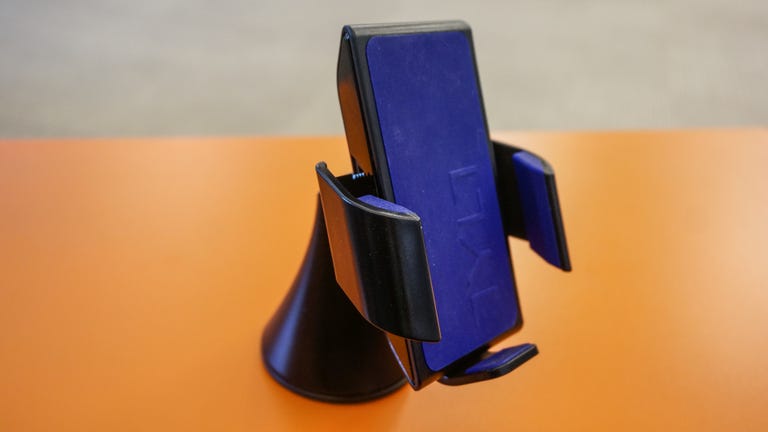 Why You Can Trust CNET
Why You Can Trust CNET Charge in the car without clumsy cables with the Tylt Vu wireless car charger
The Tylt Vu wireless car cradle makes charging a phone as easy as drop and go.
Wireless charging is cool -- I'm talking "we live in the future" level cool -- which is why I was excited to get my hands on the Tylt Vu Qi-wireless charging car mount.
The Vu comes out of the box in three parts. The main bit is the cradle. The cradle houses the wireless charging coils and is composed of black plastic. The main body measures about 2.7 inches wide by 5.25 inches tall by a bit over an inch thick, but it's further bulked out by a trio of adjustable arms that protrude from the sides and bottom. Overall, the cradle is noticeably more bulky when compared to non-charging cradles, which could be an issue when affixing it to dashboards under steep windshields or in smaller cars.
The arms hold the handset in place atop the charging cradle's face. The two side arms open to 3.6 inches wide, so you can cram a 6-inch phablet in there, and the lower arm extends about half an inch from the lower edge to accommodate tall devices.
The surfaces of the arms and cradle that come into contact with the phone are covered with a soft-touch rubbery material that is purple for my example, but gray is also available. The large charging surface is also embossed with the "TYLT" logo. Flip the cradle on its side and you'll find a small, dim indicator LED on the left edge. A solid green light indicates that everything is OK and faults are indicated by flashing. The glow is fairly dim, so it is barely noticeable in daylight and not at all distracting at night.
The cradle connects to an included mounting arm via a single ball joint. At the business end of that arm is a 2.8-inch-wide, semiadhesive "micro-gel" suction cup. The tacky cup locks into place with a lever and should stick to a dashboard as well as windshield glass.
The last piece of the puzzle is the 12-volt power cable that connects the Vu car mount to the host car. On the cradle end, the cable uses a nonstandard connection. On the car's end is a very standard, but also very bulky car power connector that features an additional a 5V 1.3A USB port on its squared face that allows for the charging of a second phone or device.
After a quick assembly, I mounted the Vu car charger to the dashboard of my test car and plugged it into the cigarette-lighter power port. That's all there is to setup and installation.
Charging is as simple as dropping a Qi-enabled mobile phone between the arms of the three-coil charging dock, closing up the arms and hitting the road. I enjoyed the simplicity of not having to fumble with cables at the beginning and end of each trip. However, my first measured stress test on the road was a bit disappointing.
I drained the battery of my LG Nexus 5 before a planned road trip and made a note of the 10 percent battery level before dropping the phone into the Vu car charger. Then I punched a destination in for screen-on navigation, cued up a playlist for audio streaming via Bluetooth, and hit the road. At the end of my 2-hour journey, the Vu had only managed to raise the battery level to 28 percent. (That's a little under 10 percent of the 5's 2300MAh battery per hour.)
Admittedly, this was a worst-case scenario for the Vu. Qi-wireless chargers are less efficient than wired USB chargers, I'd given the phone a lot of information to process and leaving the screen on in direct sunlight at max brightness for 2 hours is a massive power drain. That the Vu managed to finish this crucible with more battery charge than I'd started with is a small victory.
Later, at CNET's Car Tech Lab (ahem, my desk), the Vu fared significantly better, juicing the Nexus 5's battery from 15 percent to full in about an hour with the screen off. A second test with the screen locked on took the battery from 25 percent to full in about 3 hours. I should note that my phone got fairly warm during my screen on testing, reaching about 111 degrees F (about 44 degrees C) at its hottest point.
What you're paying for here is the convenience of not having to fumble with a cable and aesthetics, these are the Vu cradle's main (and only) advantages. With the Vu, the phone can just be dropped into the cradle, saving a few moments at the beginning and end of each trip. Plus, the user can be more clever managing the fixed power cable for a tidier cabin. There's no denying that the Qi-wireless Tylt Vu charger is a slick and cool looking way to charge a phone on the go.
But at an MSRP of $79.99 (£59.95 in the UK and AU$108.99 in Australia), the Vu wireless car charging cradle is significantly more expensive than a conventional, nonpowered mount and USB car charging cable. Additionally, the wireless Vu charges more slowly than a cable, which is why I'll likely be sticking to a 1A USB charger for the foreseeable future.


